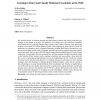Free Online Productivity Tools
i2Speak
i2Symbol
i2OCR
iTex2Img
iWeb2Print
iWeb2Shot
i2Type
iPdf2Split
iPdf2Merge
i2Bopomofo
i2Arabic
i2Style
i2Image
i2PDF
iLatex2Rtf
Sci2ools
JMLR
2006
2006
Learning to Detect and Classify Malicious Executables in the Wild
We describe the use of machine learning and data mining to detect and classify malicious executables as they appear in the wild. We gathered 1,971 benign and 1,651 malicious executables and encoded each as a training example using n-grams of byte codes as features. Such processing resulted in more than 255 million distinct n-grams. After selecting the most relevant n-grams for prediction, we evaluated a variety of inductive methods, including naive Bayes, decision trees, support vector machines, and boosting. Ultimately, boosted decision trees outperformed other methods with an area under the ROC curve of 0.996. Results suggest that our methodology will scale to larger collections of executables. We also evaluated how well the methods classified executables based on the function of their payload, such as opening a backdoor and mass-mailing. Areas under the ROC curve for detecting payload function were in the neighborhood of 0.9, which were smaller than those for the detection task. Ho...
| Added | 13 Dec 2010 |
| Updated | 13 Dec 2010 |
| Type | Journal |
| Year | 2006 |
| Where | JMLR |
| Authors | Jeremy Z. Kolter, Marcus A. Maloof |
Comments (0)

